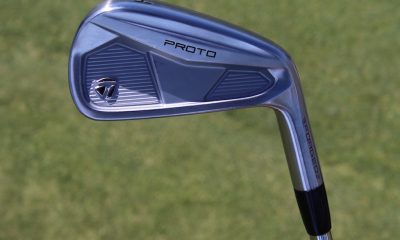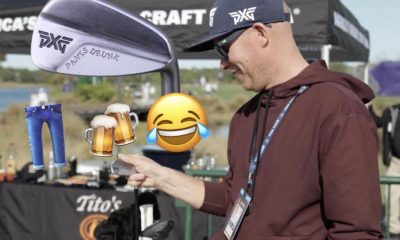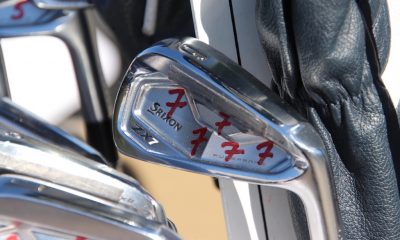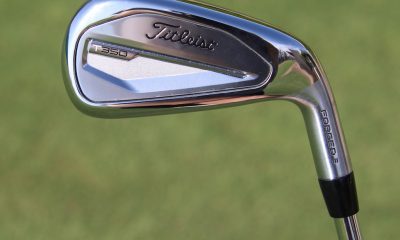Opinion & Analysis
Head to Head: Callaway Apex CF ’16, Mizuno JPX-900 Forged and Srixon Z565 irons

A few weeks ago, GolfWRX Members voted for the three game-improvement irons they most wanted to see tested head-to-head. The winners were: Callaway Apex CF ’16, Mizuno JPX-900 Forged and Titleist 716 AP1. Unfortunately, I was not able to access a Titleist 716 AP1 at my desired specs (62-degree lie, 32-degree loft), so it was replaced in the test by the iron that got the next highest amount of votes, Srixon’s Z565 irons.
I do a lot of these head-to-head equipment test videos on my YouTube Channel, but for this video I stepped it up. Each of the three irons were tested with the same shafts of the exact same length, and all the clubs had the same grips, lofts, lies and swing weights, courtesy of Tour X Golf fitters.
As always, post your comments and questions below.
Related
- Head to Head: Mizuno MP-5, PXG 0311T and Titleist 716 AP2 irons
- LIKE114
- LEGIT12
- WOW5
- LOL3
- IDHT0
- FLOP0
- OB0
- SHANK13
19th Hole
Vincenzi’s 2024 Zurich Classic of New Orleans betting preview

The PGA TOUR heads to New Orleans to play the 2023 Zurich Classic of New Orleans. In a welcome change from the usual stroke play, the Zurich Classic is a team event. On Thursday and Saturday, the teams play best ball, and on Friday and Sunday the teams play alternate shot.
TPC Louisiana is a par 72 that measures 7,425 yards. The course features some short par 4s and plenty of water and bunkers, which makes for a lot of exciting risk/reward scenarios for competitors. Pete Dye designed the course in 2004 specifically for the Zurich Classic, although the event didn’t make its debut until 2007 because of Hurricane Katrina.
Coming off of the Masters and a signature event in consecutive weeks, the field this week is a step down, and understandably so. Many of the world’s top players will be using this time to rest after a busy stretch.
However, there are some interesting teams this season with some stars making surprise appearances in the team event. Some notable teams include Patrick Cantlay and Xander Schauffele, Rory McIlroy and Shane Lowry, Collin Morikawa and Kurt Kitayama, Will Zalatoris and Sahith Theegala as well as a few Canadian teams, Nick Taylor and Adam Hadwin and Taylor Pendrith and Corey Conners.
Past Winners at TPC Louisiana
- 2023: Riley/Hardy (-30)
- 2022: Cantlay/Schauffele (-29)
- 2021: Leishman/Smith (-20)
- 2019: Palmer/Rahm (-26)
- 2018: Horschel/Piercy (-22)
- 2017: Blixt/Smith (-27)
2024 Zurich Classic of New Orleans Picks
Tom Hoge/Maverick McNealy +2500 (DraftKings)
Tom Hoge is coming off of a solid T18 finish at the RBC Heritage and finished T13 at last year’s Zurich Classic alongside Harris English.
This season, Hoge is having one of his best years on Tour in terms of Strokes Gained: Approach. In his last 24 rounds, the only player to top him on the category is Scottie Scheffler. Hoge has been solid on Pete Dye designs, ranking 28th in the field over his past 36 rounds.
McNealy is also having a solid season. He’s finished T6 at the Waste Management Phoenix Open and T9 at the PLAYERS Championship. He recently started working with world renowned swing coach, Butch Harmon, and its seemingly paid dividends in 2024.
Keith Mitchell/Joel Dahmen +4000 (DraftKings)
Keith Mitchell is having a fantastic season, finishing in the top-20 of five of his past seven starts on Tour. Most recently, Mitchell finished T14 at the Valero Texas Open and gained a whopping 6.0 strokes off the tee. He finished 6th at last year’s Zurich Classic.
Joel Dahmen is having a resurgent year and has been dialed in with his irons. He also has a T11 finish at the PLAYERS Championship at TPC Sawgrass which is another Pete Dye track. With Mitchell’s length and Dahmen’s ability to put it close with his short irons, the Mitchell/Dahmen combination will be dangerous this week.
Taylor Moore/Matt NeSmith +6500 (DraftKings)
Taylor Moore has quickly developed into one of the more consistent players on Tour. He’s finished in the top-20 in three of his past four starts, including a very impressive showing at The Masters, finishing T20. He’s also finished T4 at this event in consecutive seasons alongside Matt NeSmith.
NeSmith isn’t having a great 2024, but has seemed to elevate his game in this format. He finished T26 at Pete Dye’s TPC Sawgrass, which gives the 30-year-old something to build off of. NeSmith is also a great putter on Bermudagrass, which could help elevate Moore’s ball striking prowess.
- LIKE7
- LEGIT3
- WOW1
- LOL1
- IDHT0
- FLOP3
- OB1
- SHANK1
19th Hole
Vincenzi’s 2024 LIV Adelaide betting preview: Cam Smith ready for big week down under

After having four of the top twelve players on the leaderboard at The Masters, LIV Golf is set for their fifth event of the season: LIV Adelaide.
For both LIV fans and golf fans in Australia, LIV Adelaide is one of the most anticipated events of the year. With 35,000 people expected to attend each day of the tournament, the Grange Golf Club will be crawling with fans who are passionate about the sport of golf. The 12th hole, better known as “the watering hole”, is sure to have the rowdiest of the fans cheering after a long day of drinking some Leishman Lager.
The Grange Golf Club is a par-72 that measures 6,946 yards. The course features minimal resistance, as golfers went extremely low last season. In 2023, Talor Gooch shot consecutive rounds of 62 on Thursday and Friday, giving himself a gigantic cushion heading into championship Sunday. Things got tight for a while, but in the end, the Oklahoma State product was able to hold off The Crushers’ Anirban Lahiri for a three-shot victory.
The Four Aces won the team competition with the Range Goats finishing second.
*All Images Courtesy of LIV Golf*
Past Winners at LIV Adelaide
- 2023: Talor Gooch (-19)
Stat Leaders Through LIV Miami
Green in Regulation
- Richard Bland
- Jon Rahm
- Paul Casey
Fairways Hit
- Abraham Ancer
- Graeme McDowell
- Henrik Stenson
Driving Distance
- Bryson DeChambeau
- Joaquin Niemann
- Dean Burmester
Putting
- Cameron Smith
- Louis Oosthuizen
- Matt Jones
2024 LIV Adelaide Picks
Cameron Smith +1400 (DraftKings)
When I pulled up the odds for LIV Adelaide, I was more than a little surprised to see multiple golfers listed ahead of Cameron Smith on the betting board. A few starts ago, Cam finished runner-up at LIV Hong Kong, which is a golf course that absolutely suits his eye. Augusta National in another course that Smith could roll out of bed and finish in the top-ten at, and he did so two weeks ago at The Masters, finishing T6.
At Augusta, he gained strokes on the field on approach, off the tee (slightly), and of course, around the green and putting. Smith able to get in the mix at a major championship despite coming into the week feeling under the weather tells me that his game is once again rounding into form.
The Grange Golf Club is another course that undoubtedly suits the Australian. Smith is obviously incredibly comfortable playing in front of the Aussie faithful and has won three Australian PGA Championship’s. The course is very short and will allow Smith to play conservative off the tee, mitigating his most glaring weakness. With birdies available all over the golf course, there’s a chance the event turns into a putting contest, and there’s no one on the planet I’d rather have in one of those than Cam Smith.

Louis Oosthuizen +2200 (DraftKings)
Louis Oosthuizen has simply been one of the best players on LIV in the 2024 seas0n. The South African has finished in the top-10 on the LIV leaderboard in three of his five starts, with his best coming in Jeddah, where he finished T2. Perhaps more impressively, Oosthuizen finished T7 at LIV Miami, which took place at Doral’s “Blue Monster”, an absolutely massive golf course. Given that Louis is on the shorter side in terms of distance off the tee, his ability to play well in Miami shows how dialed he is with the irons this season.
In addition to the LIV finishes, Oosthuizen won back-to-back starts on the DP World Tour in December at the Alfred Dunhill Championship and the Mauritus Open. He also finished runner-up at the end of February in the International Series Oman. The 41-year-old has been one of the most consistent performers of 2024, regardless of tour.
For the season, Louis ranks 4th on LIV in birdies made, T9 in fairways hit and first in putting. He ranks 32nd in driving distance, but that won’t be an issue at this short course. Last season, he finished T11 at the event, but was in decent position going into the final round but fell back after shooting 70 while the rest of the field went low. This season, Oosthuizen comes into the event in peak form, and the course should be a perfect fit for his smooth swing and hot putter this week.

- LIKE12
- LEGIT3
- WOW1
- LOL1
- IDHT0
- FLOP1
- OB1
- SHANK1
Opinion & Analysis
The Wedge Guy: What really makes a wedge work? Part 1

Of all the clubs in our bags, wedges are almost always the simplest in construction and, therefore, the easiest to analyze what might make one work differently from another if you know what to look for.
Wedges are a lot less mysterious than drivers, of course, as the major brands are working with a lot of “pixie dust” inside these modern marvels. That’s carrying over more to irons now, with so many new models featuring internal multi-material technologies, and almost all of them having a “badge” or insert in the back to allow more complex graphics while hiding the actual distribution of mass.
But when it comes to wedges, most on the market today are still single pieces of molded steel, either cast or forged into that shape. So, if you look closely at where the mass is distributed, it’s pretty clear how that wedge is going to perform.
To start, because of their wider soles, the majority of the mass of almost any wedge is along the bottom third of the clubhead. So, the best wedge shots are always those hit between the 2nd and 5th grooves so that more mass is directly behind that impact. Elite tour professionals practice incessantly to learn to do that consistently, wearing out a spot about the size of a penny right there. If impact moves higher than that, the face is dramatically thinner, so smash factor is compromised significantly, which reduces the overall distance the ball will fly.
Every one of us, tour players included, knows that maddening shot that we feel a bit high on the face and it doesn’t go anywhere, it’s not your fault.
If your wedges show a wear pattern the size of a silver dollar, and centered above the 3rd or 4th groove, you are not getting anywhere near the same performance from shot to shot. Robot testing proves impact even two to three grooves higher in the face can cause distance loss of up to 35 to 55 feet with modern ‘tour design’ wedges.
In addition, as impact moves above the center of mass, the golf club principle of gear effect causes the ball to fly higher with less spin. Think of modern drivers for a minute. The “holy grail” of driving is high launch and low spin, and the driver engineers are pulling out all stops to get the mass as low in the clubhead as possible to optimize this combination.
Where is all the mass in your wedges? Low. So, disregarding the higher lofts, wedges “want” to launch the ball high with low spin – exactly the opposite of what good wedge play requires penetrating ball flight with high spin.
While almost all major brand wedges have begun putting a tiny bit more thickness in the top portion of the clubhead, conventional and modern ‘tour design’ wedges perform pretty much like they always have. Elite players learn to hit those crisp, spinny penetrating wedge shots by spending lots of practice time learning to consistently make contact low in the face.
So, what about grooves and face texture?
Grooves on any club can only do so much, and no one has any material advantage here. The USGA tightly defines what we manufacturers can do with grooves and face texture, and modern manufacturing techniques allow all of us to push those limits ever closer. And we all do. End of story.
Then there’s the topic of bounce and grinds, the most complex and confusing part of the wedge formula. Many top brands offer a complex array of sole configurations, all of them admittedly specialized to a particular kind of lie or turf conditions, and/or a particular divot pattern.
But if you don’t play the same turf all the time, and make the same size divot on every swing, how would you ever figure this out?
The only way is to take any wedge you are considering and play it a few rounds, hitting all the shots you face and observing the results. There’s simply no other way.
So, hopefully this will inspire a lively conversation in our comments section, and I’ll chime in to answer any questions you might have.
And next week, I’ll dive into the rest of the wedge formula. Yes, shafts, grips and specifications are essential, too.
- LIKE32
- LEGIT7
- WOW1
- LOL1
- IDHT2
- FLOP3
- OB1
- SHANK3
-

 19th Hole2 weeks ago
19th Hole2 weeks agoDave Portnoy places monstrous outright bet for the 2024 Masters
-

 19th Hole2 weeks ago
19th Hole2 weeks agoTiger Woods arrives at 2024 Masters equipped with a putter that may surprise you
-

 19th Hole2 days ago
19th Hole2 days agoJustin Thomas on the equipment choice of Scottie Scheffler that he thinks is ‘weird’
-

 19th Hole2 days ago
19th Hole2 days ago‘Absolutely crazy’ – Major champ lays into Patrick Cantlay over his decision on final hole of RBC Heritage
-

 19th Hole3 weeks ago
19th Hole3 weeks agoReport: Tiger Woods has ‘eliminated sex’ in preparation for the 2024 Masters
-

 19th Hole1 week ago
19th Hole1 week agoTwo star names reportedly blanked Jon Rahm all week at the Masters
-

 19th Hole1 week ago
19th Hole1 week agoReport: LIV Golf identifies latest star name they hope to sign to breakaway tour
-

 19th Hole1 week ago
19th Hole1 week agoNeal Shipley presser ends in awkward fashion after reporter claims Tiger handed him note on 8th fairway



























sumsum
Nov 16, 2016 at 6:23 pm
Rick,
It seems you Averaged 4mm toe on the Apex, and 5mm toe on the srixon – and the shots all went left….. Mizuno averaged 1mm toe and actually dispersed tighter to the line, not all grouped left. Also, you had 1.4deg and 1.6 deg of side spin with the Callaway and Srixon respectively, vs. 3.6 degrees of side spin with mizuno. This could’ve held it from achieving more distance, but more like it seems, it was third in your test, and you miss hit it more often as you tired. I would like to see you stagger the test, 1 callaway, 1 srixon, 1 mizuno…etc to produce a real test. Also, Mizuno is the only full forged head in the group – the other are multi-material constructions.
Tom
Nov 17, 2016 at 11:30 am
Huh? and there it is. ….to the rescue.
Tom
Nov 16, 2016 at 2:23 pm
Are we gonna get “impact” comments again?
Tom
Nov 16, 2016 at 2:01 pm
Wait for it……wait…… for …… it…….
Jim
Nov 16, 2016 at 1:03 pm
It doesn’t matter what the loft is. The COG and even proscribed shaft the engineers (occasionally) designed it around to produce the loft needed for the ‘X’ to play as it should. A (‘7’) iron needs to achieve a ball flight apex to land softly. If it does and yields more distance then they did thier job – well.
In ’97 I played Diawa Comps. Took a bit of ‘getting used to’
as they looked like shovels compared to my Miura’s, TZoids
or VIP’s but the thin Titanium face and sharp grooves
allowed for Tungsten inserts to lower the CG enough they
went plenty high, stopped dead with 5irons or got nice draw with a 6 on the greens and were almost 20yds longer. A well needed boost following 3 fractured vertibrea and lead shoulder/hand injuries.
Everyrhing has changed dramatically in 40 years. Jack coulda hit a 200yd 7 iron back then, it just never would of stopped on the green. Even most ‘players’ clubs PW have gone from 48 to 46 or 46.5 because the balls & shafts and better head design allow for it.
Great work running these tests – and yes, even the grip should be the same. The heads however should be checked to be exact MFR lofts – whether or not there’s a difference between the club’s designated ‘number’…the launch data will tell us if one has been made ‘too strong’ and comes into a green too hot.
thanks for doing these 🙂
Jack
Nov 16, 2016 at 8:11 am
So what you are saying is a lot more people are striping 2 or even 1 irons down the fairway nowadays. Amazing.
Philip
Nov 15, 2016 at 10:40 pm
I like that you are getting away from numbers on the clubs as that loft was called a 5 iron when I started playing golf. You shouldn’t even mentioned the marketing number on the bottom of the club, but if someone needs to think that they hit their club with a 7 on it the same distance as my club with a 5 on it – whatever turns their crank. What was the length of the irons? All 37 inches?
Brian
Nov 16, 2016 at 10:12 am
I get so sick of listening to people complain about the loft vs. Number on the bottom of your club. Nobody cares what the 5i was back in your day…you also walked to school in the snow, uphill, both ways.
I bet your 5 iron of yester-year didn’t launch the ball as high as the current 7 irons.
Philip
Nov 16, 2016 at 11:34 am
Wow – hit a nerve eh? Didn’t know back in the day was only 5 years ago – what, you age in dog years? Chill dude – reviewing taking about lofts inside of what has become a meaningless number only makes it easier to compare apple to apples. Oh, and a higher launch isn’t always needed or better – horses for courses.
Spanky
Nov 16, 2016 at 10:58 am
You score is what counts in golf, right? If it makes you feel better to have a “traditional” lofted 7 iron, go for it. I see no difference though in someone wanting a non “traditional” 7 iron, than what you want and as long as fitted for the clubs. It makes zero difference. Heck, you are free to use a persimmon 1 wood with a 20 year old steel shaft if that makes you feel better. Just hit the ball and have fun. If it worries you that someone says they hit their 7 iron longer than your 7 iron, eh, I think you just need to let it go and learn to give jabs right back about something else.
For kicks though, go take a 7 iron from decades ago and get on trackman and compare to these newer lower lofted 7 irons. I think you’ll quickly understand the reasons for lower lofts these days vs more traditional lofts. If that doesn’t make sense to you, then go bend the loft down on a 20 year old 7 iron to match today’s lofts (~30 degrees) and see what you get on the course. Let me know how those bullets work out as they only go a few yards off the ground and skid off the back of a green. It is more than just the loft.
No matter how you look at it, everyone has to hit the club and post a score no matter what is stamped on the club. And if you really think about it, there is no “standard” loft any longer.
And beyond lofts, the is no standard on what “regular”, “stiff” etc. means in shafts yet many take it for granted those all mean the same thing across manufacturers. They don’t.
Get fitted. If you end up with a 35 degree 7 iron, bravo. If its 28 degrees, bravo as well.
Philip
Nov 16, 2016 at 11:53 am
Another nerve pinched :o) – for the record I have been getting fitted for a while and have ended up with clubs from 2006 that are only “one” number behind the current crop and from what I see there never was a standard so why even bother with random numbers on clubs. Personally I couldn’t care less about the numbers because in the end I decide on clubs via lofts to space my yardages. However, the effect of the decreased lofts and increased lengths just means I have to tweak lofts more than before and add more lead tape than before after cutting down the shaft lengths, as the OEMs use lighter heads to prevent the swing weights from getting to heavy with the longer lengths. My club selection is based on what I need to get my lowest score. I don’t care about the numbers on my clubs, I figure out the lofts that work – my 3W is the length of a 2W (42.5 inches) with the loft of a 4W (18), or is that a 7W now… I don’t care, as in the end all I need is to figure out the length/loft combination that maximizes my potential – the numbers on the clubs are irrelevant other than to make it easier to pull a club. Only makes it a bit trickier when looking for clubs to replace worn out ones.